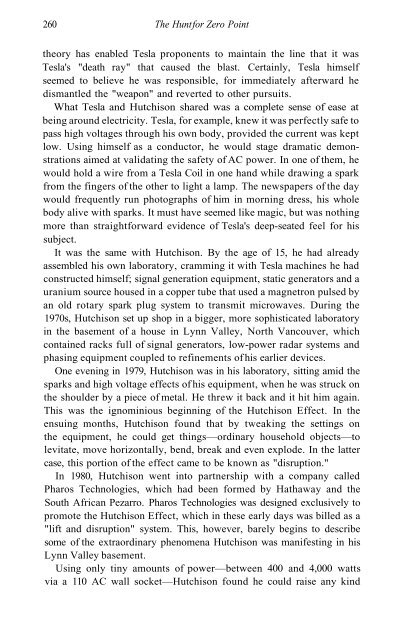ScienceDirect - Technol Rep Tohoku Univ ... - Garryck Osborne
ScienceDirect - Technol Rep Tohoku Univ ... - Garryck Osborne
ScienceDirect - Technol Rep Tohoku Univ ... - Garryck Osborne
You also want an ePaper? Increase the reach of your titles
YUMPU automatically turns print PDFs into web optimized ePapers that Google loves.
260 The Hunt for Zero Point<br />
theory has enabled Tesla proponents to maintain the line that it was<br />
Tesla's "death ray" that caused the blast. Certainly, Tesla himself<br />
seemed to believe he was responsible, for immediately afterward he<br />
dismantled the "weapon" and reverted to other pursuits.<br />
What Tesla and Hutchison shared was a complete sense of ease at<br />
being around electricity. Tesla, for example, knew it was perfectly safe to<br />
pass high voltages through his own body, provided the current was kept<br />
low. Using himself as a conductor, he would stage dramatic demonstrations<br />
aimed at validating the safety of AC power. In one of them, he<br />
would hold a wire from a Tesla Coil in one hand while drawing a spark<br />
from the fingers of the other to light a lamp. The newspapers of the day<br />
would frequently run photographs of him in morning dress, his whole<br />
body alive with sparks. It must have seemed like magic, but was nothing<br />
more than straightforward evidence of Tesla's deep-seated feel for his<br />
subject.<br />
It was the same with Hutchison. By the age of 15, he had already<br />
assembled his own laboratory, cramming it with Tesla machines he had<br />
constructed himself; signal generation equipment, static generators and a<br />
uranium source housed in a copper tube that used a magnetron pulsed by<br />
an old rotary spark plug system to transmit microwaves. During the<br />
1970s, Hutchison set up shop in a bigger, more sophisticated laboratory<br />
in the basement of a house in Lynn Valley, North Vancouver, which<br />
contained racks full of signal generators, low-power radar systems and<br />
phasing equipment coupled to refinements of his earlier devices.<br />
One evening in 1979, Hutchison was in his laboratory, sitting amid the<br />
sparks and high voltage effects of his equipment, when he was struck on<br />
the shoulder by a piece of metal. He threw it back and it hit him again.<br />
This was the ignominious beginning of the Hutchison Effect. In the<br />
ensuing months, Hutchison found that by tweaking the settings on<br />
the equipment, he could get things—ordinary household objects—to<br />
levitate, move horizontally, bend, break and even explode. In the latter<br />
case, this portion of the effect came to be known as "disruption."<br />
In 1980, Hutchison went into partnership with a company called<br />
Pharos <strong>Technol</strong>ogies, which had been formed by Hathaway and the<br />
South African Pezarro. Pharos <strong>Technol</strong>ogies was designed exclusively to<br />
promote the Hutchison Effect, which in these early days was billed as a<br />
"lift and disruption" system. This, however, barely begins to describe<br />
some of the extraordinary phenomena Hutchison was manifesting in his<br />
Lynn Valley basement.<br />
Using only tiny amounts of power—between 400 and 4,000 watts<br />
via a 110 AC wall socket—Hutchison found he could raise any kind


